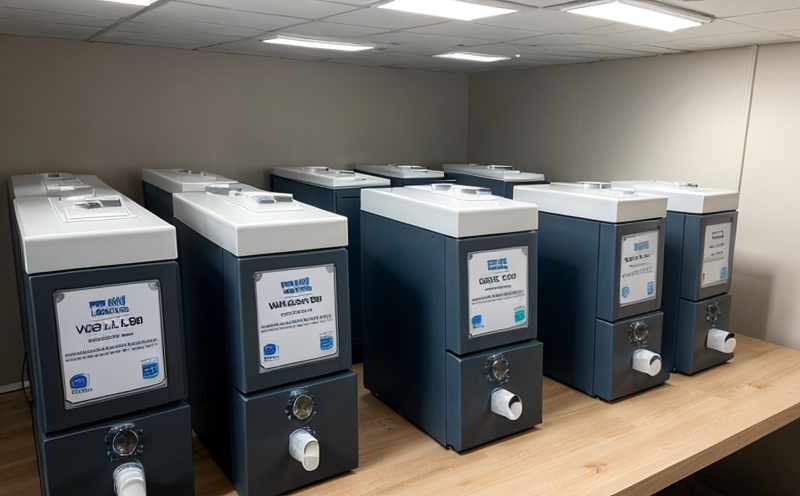GB T 2912.3 Textiles Determination of formaldehyde Gas chromatography method
The GB/T 2912.3 standard is an essential guideline for the determination of volatile organic compounds (VOCs) including formaldehyde in textiles. This method employs gas chromatography, a precise and reliable analytical technique, to measure trace amounts of these compounds which may be present in various textile products.
The primary purpose of this testing procedure is to ensure that textile materials conform to safety standards set forth by the Chinese government, particularly regarding formaldehyde emissions. Excessive levels of formaldehyde can pose health risks, especially for prolonged exposure during clothing production or use. By adhering to GB/T 2912.3, manufacturers and suppliers can guarantee their products meet stringent quality control requirements.
In practice, this involves several key steps: first, samples are prepared according to the specified protocol outlined in the standard. This includes cutting out representative pieces of fabric and ensuring they represent typical conditions under which the material will be used. Next, these samples undergo rigorous extraction processes aimed at liberating any volatile organic compounds including formaldehyde from within the sample.
The extracted components are then injected into a gas chromatograph equipped with appropriate detectors designed specifically for detecting trace amounts of gases like formaldehyde. Through this process, the exact concentration levels can be quantified accurately down to parts per million (ppm). Finally, results must meet specific acceptance criteria defined by GB/T 2912.3 itself.
It is important to note that proper sample preparation plays a crucial role in obtaining accurate measurements since even slight deviations could lead to erroneous conclusions about the actual level of formaldehyde present. Therefore, it’s recommended to follow all prescribed procedures closely when preparing samples for analysis.
The importance of this testing cannot be overstated given its direct impact on public health and safety. Many countries around the world have similar regulations aimed at reducing harmful emissions from consumer goods such as clothing and bedding items. By complying with GB/T 2912.3, businesses ensure they remain compliant not just domestically but also internationally where international standards like ISO or ASTM might apply.
For those responsible for quality assurance within their organizations, familiarity with these testing methods is crucial. It allows them to make informed decisions about sourcing materials and ensuring products meet all necessary safety requirements. Additionally, understanding the nuances of each step involved in this process helps troubleshoot potential issues early on, thereby minimizing costly delays or rejections later down the line.
Overall, mastery over GB/T 2912.3 is vital for anyone working within the textile industry who needs to ensure their products adhere strictly to formaldehyde emission limits. Proper implementation of this testing protocol ensures not only compliance with local regulations but also contributes positively towards building trust among consumers regarding product safety.
Applied Standards
- GB/T 2912.3 - Textiles Determination of formaldehyde Gas chromatography method
Industry Applications
The application of GB/T 2912.3 extends beyond just compliance testing; it also serves as a valuable tool for research and development purposes within the textile industry. R&D engineers often use this methodology to study new materials or processes that could potentially reduce formaldehyde emissions without compromising on performance.
Quality managers rely heavily on GB/T 2912.3 when setting internal standards for their factories, ensuring all produced goods comply with both national and international safety norms. Similarly, compliance officers find this standard indispensable during audits or inspections conducted by regulatory bodies.
Procurement teams benefit from knowing how to interpret results obtained through GB/T 2912.3 so they can source raw materials that meet strict formaldehyde emission limits. This knowledge also aids them in negotiating terms with suppliers who adhere strictly to these standards, thus maintaining consistent product quality throughout the supply chain.
Moreover, this testing method is particularly useful for evaluating existing products already on market shelves. By periodically sampling and analyzing these items using GB/T 2912.3, companies can identify any issues early enough to address them proactively before they escalate into broader concerns among customers or regulatory authorities.
In summary, the wide applicability of GB/T 2912.3 makes it an indispensable part of every textile manufacturer's quality assurance toolkit. Whether used for production control, research & development, compliance verification, or product evaluation, this standard plays a pivotal role in safeguarding both consumer health and environmental sustainability.
Eurolab Advantages
At Eurolab, we pride ourselves on providing comprehensive textile testing services that align perfectly with GB/T 2912.3 standards. Our team of experts ensures accurate and reliable results every time, thanks to our state-of-the-art laboratory facilities equipped with advanced instrumentation.
We understand the importance of precision in formaldehyde detection, which is why we employ highly trained technicians who are fully conversant with all aspects of this testing procedure. From sample preparation through analysis to final reporting, each step follows strict protocols dictated by GB/T 2912.3 ensuring consistency and accuracy.
Our commitment to quality extends beyond just meeting basic compliance requirements; we strive for excellence in every aspect of our service delivery. This includes offering flexible turnaround times tailored to meet specific project deadlines while maintaining high standards throughout. We also provide detailed reports that go beyond mere numerical values, giving clients comprehensive insights into their product's formaldehyde content.
Furthermore, Eurolab stays abreast of any updates or revisions made to GB/T 2912.3 ensuring our methodologies remain current and relevant. This continuous learning approach allows us to stay ahead in providing accurate testing results that comply with evolving regulatory landscapes.
In summary, choosing Eurolab for your textile formaldehyde testing needs means benefiting from experienced professionals committed to delivering top-notch service backed by robust laboratory infrastructure and cutting-edge technology.





